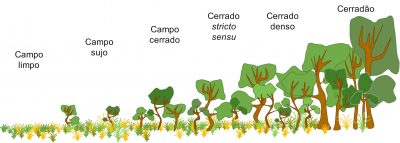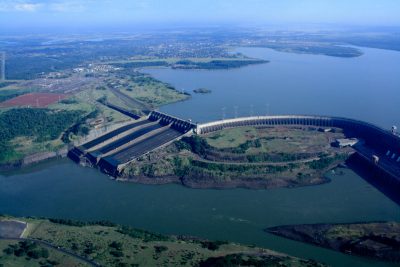The Cerrado biome
PDF1. A unique set of ecosystems in the heart of South America

A biome being a set of ecosystems, the Cerrado biomeis composed of different ecosystems, sometimes forests like gallery forests along rivers or dry forests (mata seca) but the predominant vegetation is savannas and tropical grasslands. The Cerrado is usually referred to as the Brazilian savanna. It presents different physiognomies defined according to tree cover (Figure 1):
- Ecosystems with very open vegetation: the campos limpos, rocky campos ;
- Ecosystems with more tree and shrub cover: campos sujos, campo cerrado, cerrado sensu stricto;
- the Cerradão, which is considered a forest devoid of a continuous herbaceous cover.
Several reasons have been put forward to explain this variation in physiognomy, including nutrient availability and access to water, fire regimes, and soil aluminum content. It is likely that the interactions between the different factors play a role in defining the different physiognomies.
2. Biodiversity: the richest savanna in the world

3. Water from the Cerrado
The Cerrado plays a major role in Brazil in water supply and water quality control, and is sometimes referred to as the “water box of Brazil”, the “cradle of Brazil’s waters” or the “arc of springs”. The vegetation of the Cerrado avoids too much water interception by foliage (as is often the case in forests), allows efficient water retention and infiltration into the soil and filtration of the water that feeds aquifers and rivers.

In addition, the vegetation of the Cerrado also plays an important role recharging the Guarani aquifer, one of the largest aquifers on the planet. It is understood that the waters of the Cerrado are also very important for agriculture.
4. Threats to the Cerrado
Although it hosts incredible biodiversity, the Cerrado is one of the most threatened biomes in South America, as the main conservation efforts are focused on the Amazonian forest (4.2 million km²) and the Atlantic forest (1.1 million km²). Today only a small area of the Cerrado is under legal protection, about 2.2%, although it is facing drastic changes in land use. Between 1990 and 2010, the Cerrado lost 265,595 km2 (about half of France); between 2002 and 2009 alone, 92,712 km2 (15% of France) of natural ecosystems were converted into agricultural land, a decrease of 8.1% compared to 3.1% in the Amazon [1],[2]. Over the past four decades, the development of livestock farming and intensive agriculture has exacerbated social inequalities, biodiversity losses, landscape fragmentation, biological invasions, soil erosion, water pollution and land degradation. Currently, some policies designed to sequester carbon, such as REDD+ payment schemes, threaten the open landscapes of Cerrado through afforestation projects.
Notes and References
Cover. Ipê-amarelo, Ipê do Cerrado, Handroanthus ochraceus, or golden trumpet tree, tree with yellow flowers emblematic of the Cerrado of Brazil. [Source : Photo © S. Le Stradic]
[1] Beuchle, R., Grecchi, R.C., Shimabukuro, Y.E., Seliger, R., Eva, H.D., Sano, E., & Achard, F. 2015. Land cover changes in the Brazilian Cerrado and Caatinga biomes from 1990 to 2010 based on a systematic remote sensing sampling approach. Applied Geography 58: 116-127.
[2] Espírito-Santo, M.M., Leite, M.E., Silva, J.O., Barbosa, R.S., Rocha, A.M., Anaya, F.C., & Dupin, M.G. V. 2016. Understanding patterns of land-cover change in the Brazilian Cerrado from 2000 to 2015. Philosophical Transactions of the Royal Society B: Biological Sciences 371: 20150435.




